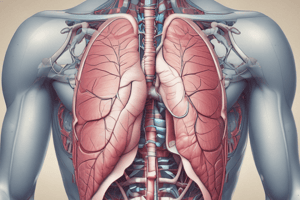Podcast
Questions and Answers
Which nerve innervates the diaphragm?
Which nerve innervates the diaphragm?
- Glossopharyngeal nerve
- Phrenic nerve (correct)
- Facial nerve
- Vagus nerve
What is the origin of the diaphragm?
What is the origin of the diaphragm?
- Hyoid bone
- Laryngeal prominence
- Thyroid cartilage
- Inferior costal cartilages (correct)
Which structure does the right crus of the diaphragm help prevent from entering the thorax?
Which structure does the right crus of the diaphragm help prevent from entering the thorax?
- Lungs
- Heart
- Stomach (correct)
- Duodenum
What is the action of the diaphragm during relaxed (quiet) inhalation?
What is the action of the diaphragm during relaxed (quiet) inhalation?
Which phrenic nerve contributes to the innervation of the diaphragm?
Which phrenic nerve contributes to the innervation of the diaphragm?
Flashcards are hidden until you start studying
Study Notes
- The diaphragm is a muscle that separates the thoracic cavity from the abdominal cavity and plays a key role in respiration.
- The diaphragm develops from several sources including the septum transversum, pleuroperitoneal membranes, dorsal mesentery of the esophagus, and muscular ingrowth from the body wall.
- The septum transversum is the initial contributor to the diaphragm and provides cells that will become skeletal muscle. These cells invade all other parts of the developing diaphragm and eventually all parts fuse to cut off pericardioperitoneal canals.
- The septum transversum is located near the head and is closest to spinal segments C3-C5, which allows nerve fibers to grow into the septum transversum prior to its descent, innervating it.
- During development, the phrenic nerve (C3-C5) grows longer and peels away from the thoracic wall to follow the descent of the developing diaphragm.
- The diaphragm has a complex origin as numerous components fuse together as the embryo folds cranio-caudally, which allows the main body cavity to be divided into the eventual thorax and abdomen and pulls the phrenic nerve from the cervical spinal segments away from the body wall and towards the lumbar region.
- The respiratory tract develops as a diverticulum from the gut tube at the level of the pharynx.
- The major divisions of bronchia are asymmetric in number, size and shape to accommodate placement of the heart.
- The larynx and respiratory epithelium are described in detail in another video.
- The larynx is a cartilaginous structure located at the entrance of the trachea and plays a role in protecting the airway and producing sound.
- The trachea, which is the first part of the respiratory system, is described in terms of its structural composition, including its respiratory epithelium, and asymmetrical bifurcation.
- The hyoid bone, laryngeal cartilages, and functionally significant membranes/ligaments are identified and described.
- The take-home messages from the video include the complicated origin of the diaphragm and the role it plays in respiration, as well as the development of the respiratory system as a diverticulum from the gut tube and the asymmetric major divisions of bronchia.
Studying That Suits You
Use AI to generate personalized quizzes and flashcards to suit your learning preferences.




